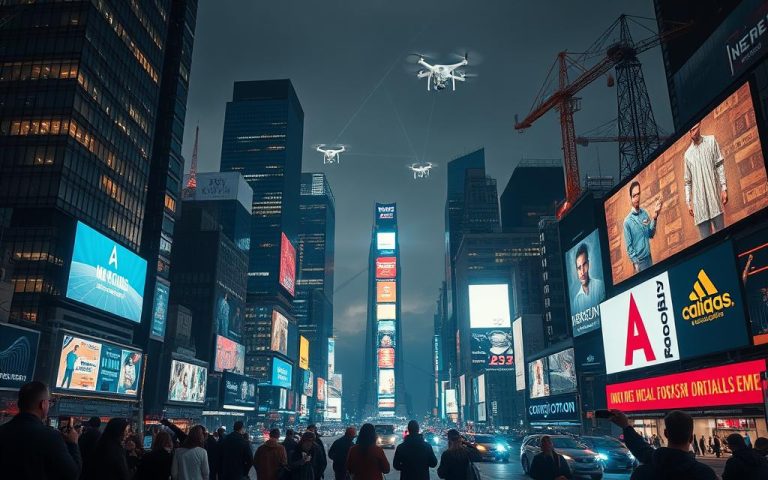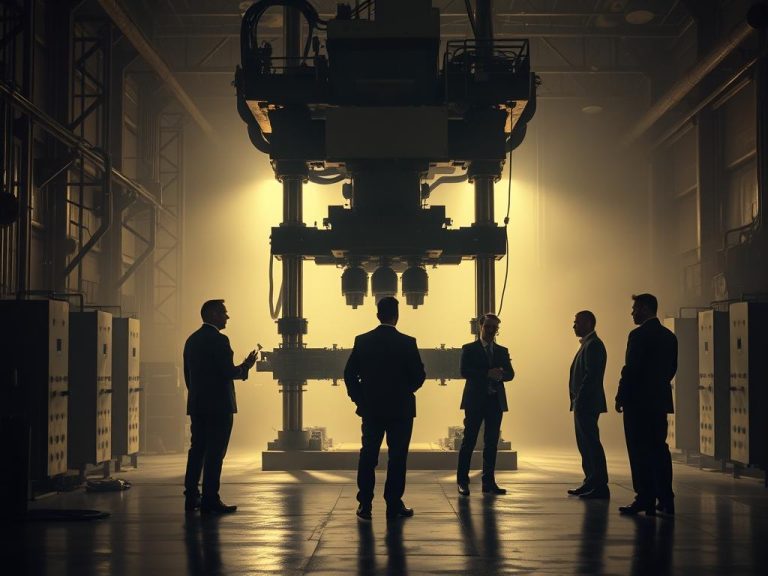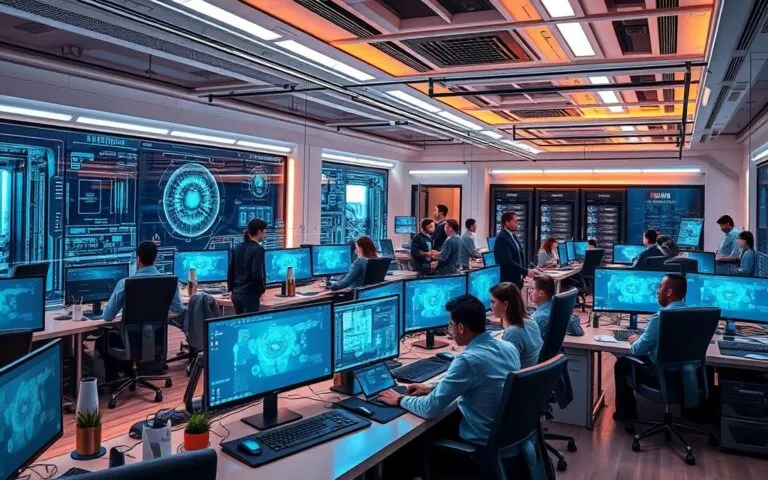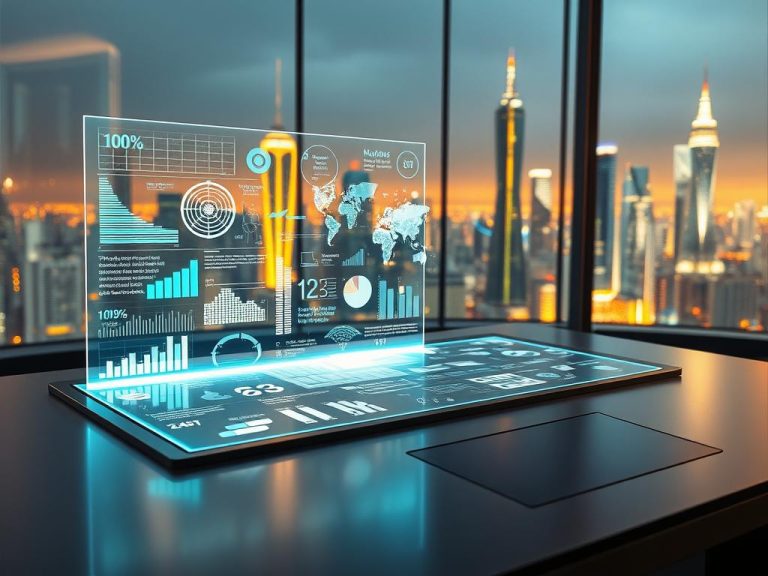Is Technology Evolving Faster Than We Can Handle?
Humanity has coevolved with tools for millions of years, but the last century has seen an unprecedented acceleration. From stone tools to smartphones, the pace of innovation has skyrocketed. Today, smartphones are within arm’s reach for most people, symbolizing how deeply modern technologies are woven into daily life.
Fields like AI, robotics, and nanotechnology are growing exponentially, reshaping the world at a dizzying speed. While these advancements solve pressing problems, they also introduce new societal challenges. Privacy concerns, job automation, and mental health impacts are just a few examples of the impact rapid progress can have.
According to the Edelman Trust Barometer, 60% of people globally distrust tech companies. This highlights the growing disconnect between innovation and cultural integration. As Peter Diamandis argues in his book, The Future Is Faster Than You Think, the gap between technological breakthroughs and societal adaptation is widening.
This section explores whether the future of innovation is outpacing our ability to adapt, examining both the benefits and challenges of this rapid evolution.
The Historical Pace of Technological Advancement
From rudimentary tools to advanced gadgets, the timeline of innovation has been anything but linear. Over 3.3 million years, humans have progressed from using Oldowan stone tools to harnessing the power of quantum computing. This journey highlights the gradual yet transformative nature of development.
The last century, however, stands out as a period of unprecedented acceleration. While it took 38 years for radio to achieve widespread adoption, smartphones saturated the market in just five years. This stark contrast underscores the rapid pace of modern technologies.
From Stone Tools to Smartphones
Early tools were simple, designed for survival. Over time, they evolved into complex devices like smartphones, which integrate GPS, cellular communication, cameras, and software. This convergence of technologies exemplifies how innovation builds upon existing foundations.
The Acceleration Curve of the Last Century
The 20th century marked a turning point. The digital revolution began, and progress became exponential. Concepts like Moore’s Law, which predicts the doubling of processing power every two years, illustrate this acceleration. Ray Kurzweil’s theory of “combinatorial innovation” further explains how combining existing technologies drives rapid advancements.
As we navigate this fast-evolving world, understanding the historical context of innovation helps us appreciate both its potential and its challenges. The journey from stone tools to artificial intelligence is a testament to human ingenuity and adaptability.
Is Technology Advancing Too Quickly? The Modern Dilemma
Modern innovations are reshaping society, but their speed often outpaces our ability to adapt. Over half of digital transformations fail due to poor change management, highlighting the disconnect between new technologies and their integration into business and society.
Take AR and VR as examples. Despite billions in investments, adoption remains limited. Similarly, cryptocurrencies face volatility, with El Salvador embracing Bitcoin while China imposes bans. These cases underscore the challenges of balancing innovation with stability.

CRISPR technology exemplifies the ethical quagmire of rapid progress. While it holds immense medical potential, its misuse raises significant risks. The pandemic accelerated remote work adoption, but it also exposed gaps in regulatory frameworks. Corporate R&D speeds often outpace approval timelines, creating friction in systems designed to ensure safety.
Blockchain’s promise is undeniable, yet consumer comprehension remains a barrier. As Thomas Friedman notes, society faces a 5-7 year adaptation crisis. Social media’s role in spreading anti-vax conspiracies further illustrates the implications of unchecked innovation.
“The gap between technological breakthroughs and societal adaptation is widening,” says Gary Marchant.
China’s AI surveillance contrasts sharply with Western ethical debates, highlighting differing approaches to governance. Meanwhile, FCC tech-related complaints have surged by 300% since 2015, signaling growing public concern. These examples reveal the complex interplay between progress and its societal impact.
Exponential Growth: Why Tech Progress Feels Overwhelming
The pace of innovation has shifted from gradual to exponential, leaving many struggling to keep up. This rapid acceleration is driven by the law of accelerating returns, a principle that explains how advancements build upon each other to create faster progress over time.
Ray Kurzweil, a prominent futurist, argues that computing power doubles every 18 months. This exponential curve has reshaped industries, from healthcare to renewable energy. For example, the cost of smartphone components has dropped by 97% since 2007, making advanced systems accessible to billions.
The Law of Accelerating Returns
Kurzweil’s law of accelerating returns highlights how each innovation fuels the next. This principle is evident in the growth of transistor counts, which have surged from 2,300 in 1971 to 114 billion in 2022. Such advancements enable modern smartphones to outperform 1990s supercomputers at a fraction of the cost.
Metcalfe’s Law further amplifies this effect. As networks grow, their value increases exponentially. This phenomenon is driving breakthroughs in fields like machine learning, where AI accelerates drug discovery timelines and reduces costs.
How Computing Power Redefines Innovation Timelines
Computing power is at the heart of this transformation. Renewable energy storage costs have plummeted by 88% since 2010, thanks to advancements in battery technology. Similarly, quantum computing promises to disrupt current paradigms, offering solutions to problems once deemed unsolvable.
The COVID-19 vaccine development is a prime example of accelerated innovation. What typically takes a decade was achieved in under a year, showcasing the potential of exponential growth in addressing global challenges.
| Year | Transistor Count | Example Device |
|---|---|---|
| 1971 | 2,300 | Intel 4004 |
| 2022 | 114 billion | Apple M1 Max |
As we look to the future, the gap between innovation and societal adaptation continues to widen. Understanding these exponential trends is crucial for navigating the challenges and opportunities they bring. For more insights, explore how exponential growth is shaping our world.
The Double-Edged Sword of Technological Convergence
The fusion of multiple technologies is reshaping industries at an unprecedented rate. This convergence creates immense opportunities but also introduces significant challenges. From AI-powered robotics to smart city infrastructures, the blending of innovations is accelerating progress while raising critical questions about ethics, regulation, and security.
AI Meets Robotics: A Case Study
Boston Dynamics’ Atlas robot exemplifies the power of combining artificial intelligence with robotics. This hybrid system performs complex tasks, from navigating rough terrain to lifting heavy objects. Such advancements highlight the potential of converged technologies to revolutionize industries like manufacturing and logistics.
When Technologies Collide (and Accelerate)
The integration of IoT and 5G is enabling smart city infrastructures, improving efficiency in transportation and energy management. Similarly, CRISPR-Cas9 combined with machine learning is advancing gene therapy, offering hope for treating genetic disorders. However, these innovations also pose risks, such as cybersecurity vulnerabilities in converged automotive systems.
- 37% faster innovation cycles in converged tech sectors.
- Blockchain’s role in supply chain management.
- Quantum computing’s impact on cryptography standards.
Regulatory gaps in AI-driven medical diagnosis systems further complicate the landscape. As these products evolve, policymakers must address ethical concerns and ensure public safety. The convergence of technologies is a powerful force, but its trajectory must be carefully managed to balance progress with societal well-being.
Societal Adaptation Lag: Why Humans Struggle to Keep Up
As innovation accelerates, society often struggles to adapt, creating a gap between progress and integration. This lag is evident in how new systems take time to become culturally accepted. Thomas Friedman highlights this disconnect, noting that societal adaptation often lags 10-15 years behind tech cycles.

Social media is a prime example. From its inception in 2004 to widespread adoption in the 2020s, it took nearly two decades for platforms to integrate fully into daily life. Similarly, the gig economy faces challenges as labor laws struggle to keep up with platform business models.
The 10-Year Gap Between Innovation and Cultural Integration
Innovation moves at a rapid pace, but cultural integration is slower. The GDPR implementation timeline, for instance, highlights this gap. While the data economy grew exponentially, it took years for comprehensive privacy laws to catch up.
Drone regulation is another case. The FAA’s rules lag behind the proliferation of commercial drones, creating uncertainty in industries like logistics and delivery. This mismatch between innovation and regulation underscores the need for agile governance.
Legislation in the Age of Disruption
New technologies often outpace legislation, leaving gaps in oversight. For example, genomic data privacy laws are still evolving, raising concerns about misuse. Similarly, the EU AI Act contrasts sharply with the US’s state-by-state approach, highlighting inconsistencies in governance.
Cryptocurrency tax reporting is another challenge. As digital currencies gain traction, tax authorities are scrambling to develop frameworks. On average, new tech categories face a 23-month regulatory lag, creating friction in management and compliance.
| Technology | Regulatory Lag | Impact |
|---|---|---|
| Social Media | 10 years | Cultural integration |
| Drones | 5 years | Industry uncertainty |
| Genomic Data | 7 years | Privacy concerns |
| Cryptocurrency | 23 months | Tax reporting challenges |
As we navigate this era of rapid change, addressing the impactof societal adaptation lag is crucial. Balancing innovation with effective governance will ensure that progress benefits everyone.
Privacy in the Digital Age: A Casualty of Speed?
In today’s digital landscape, privacy has become a fragile commodity. As data collection grows more pervasive, individuals and organizations face mounting concerns about how their information is used. From biometric scans in retail stores to AI-driven behavioral predictions, the implications of unchecked data practices are profound.

Regulatory frameworks like the EU’s GDPR and Canada’s PIPEDA aim to address these issues, but the US lags behind. This disparity highlights the global challenge of balancing innovation with security. Meanwhile, data breaches have surged by 63% since 2020, exposing sensitive information on an unprecedented scale.
The $240 billion data brokerage industry thrives on collecting and reselling personal details. Location data, for instance, is often sold without users’ knowledge. Cookie-less tracking technologies are emerging as alternatives, but they raise new questions about transparency and consent.
China’s Social Credit System exemplifies the extremes of data-driven governance. By monitoring citizens’ behavior, it creates a culture of surveillance that contrasts sharply with Western values of individual freedom. Deepfake technology further complicates the landscape, making it harder to distinguish truth from manipulation.
Quantum computing poses another challenge. Its potential to break current encryption standards could render existing security measures obsolete. As companies and governments grapple with these issues, the need for robust, future-proof solutions becomes clear.
“The gap between technological innovation and regulatory adaptation is widening,” says a cybersecurity expert.
Addressing these challenges requires a multifaceted approach. Zero-knowledge encryption and synthetic data are promising tools, but their adoption remains limited. As we navigate this complex terrain, the privacy of individuals must remain a top priority.
Job Displacement and the Automation Paradox
The rise of automation is reshaping industries, creating both challenges and opportunities. According to McKinsey, 47% of US jobs are at high risk of automation. This shift is transforming the workforce, with manufacturing seeing a 30% increase in automation since 2015.
White-collar roles are not immune. AI is replacing tasks in legal and document review, raising concerns about job security. While automation boosts efficiency, it also highlights the need for effective reskilling programs. However, gaps in these initiatives leave many workers unprepared for the changing landscape.

Universal basic income (UBI) pilot programs offer a potential solution. Early results show promise in addressing economic insecurity caused by job displacement. For example, Finland’s UBI experiment improved participants’ well-being without reducing employment rates.
Different countries approach workforce transitions differently. Germany’s proactive reskilling strategies contrast sharply with the US’s reactive measures. This disparity underscores the importance of forward-thinking policies in navigating the automation paradox.
The gig economy further complicates the picture. While it offers flexibility, it also creates precarity, leaving workers without traditional employment benefits. Age-based tech adoption disparities add another layer of complexity, as older workers often struggle to adapt to new tools.
| Country | Strategy | Outcome |
|---|---|---|
| Germany | Proactive reskilling | Lower unemployment rates |
| US | Reactive measures | Higher job displacement |
Robotic process automation (RPA) case studies reveal both benefits and challenges. While RPA improves efficiency, it also displaces workers, highlighting the need for balanced implementation. Neuroprosthetics, on the other hand, offer new opportunities for individuals with disabilities, potentially transforming the employment landscape.
As automation continues to evolve, companies must prioritize ethical practices and invest in employee learning. Balancing innovation with social responsibility will ensure that the benefits of automation are shared equitably.
Mental Health in an Always-Connected World
The constant connectivity of modern life has reshaped how we interact, but at what cost to our mental well-being? With smartphones and social media deeply embedded in daily routines, the effects on mental health are becoming increasingly evident. Studies show a 40% increase in teen depression rates linked to excessive social media use, highlighting the impact of these platforms.
One major factor is the dopamine-driven design of notifications. Apps are engineered to keep users engaged, often at the expense of their mental health. The phenomenon of “phubbing”—ignoring others in favor of smartphones—further strains interpersonal relationships. These patterns contribute to feelings of isolation and anxiety.
The Social Media Isolation Effect
Platforms like TikTok, with an average attention span of just 8.25 seconds, are reshaping how people consume information. This rapid content consumption can lead to decreased focus and increased stress. Meanwhile, the digital detox retreat market has grown by 300% since 2018, reflecting growing concerns about tech overuse.
Generational differences also play a role. Generation Z tends to use tech more intensively than Millennials, leading to varying effects on mental health. For example, constant context switching due to notifications can result in a 27% productivity loss, adding to workplace stress.
AI-driven mental health chatbots offer some hope, with studies showing a 20% reduction in depressive symptoms in certain cases. However, the risks of neural interface addiction loom on the horizon, raising new questions about the future of mental health in a tech-driven world.
Environmental Costs of Rapid Tech Obsolescence
The rapid turnover of tech products is creating a growing environmental crisis. In 2021 alone, 53 million metric tons of e-waste were generated globally. This waste, often laden with toxic materials, poses significant challenges for ecosystems and human health.
Planned obsolescence in smartphone design exacerbates the problem. The average lifespan of a cell phone is just 18 months, driving constant upgrades and disposal. This cycle strains natural resources, particularly rare earth minerals, which are essential for tech production but environmentally costly to extract.
Right-to-repair legislation is emerging as a solution. Efforts in the US and EU aim to make products easier to repair and recycle. Companies like Fairphone and Framework are leading the way with modular designs that extend product lifespans.
Cryptocurrency’s energy consumption is another concern. Bitcoin mining uses as much energy as Argentina annually, highlighting the need for sustainable alternatives. Meanwhile, the circular economy is gaining traction, with initiatives like Best Buy’s recycling programs reducing e-waste.
EV battery recycling rates vary by manufacturer, with some companies achieving up to 95% efficiency. Data centers, however, consume vast amounts of water—1.7 liters per Google search—underscoring the need for greener development practices.
| Issue | Impact | Solution |
|---|---|---|
| E-waste | 53 million metric tons annually | Circular economy initiatives |
| Planned obsolescence | Short product lifespans | Right-to-repair legislation |
| Cryptocurrency energy use | Bitcoin = Argentina’s energy consumption | Sustainable mining practices |
Solar panel degradation and fast fashion tech also contribute to the problem. Biodegradable electronics research offers hope, with breakthroughs in materials that break down naturally. Space junk mitigation technologies are another frontier, addressing the growing debris in Earth’s orbit.
As the tech industry evolves, balancing innovation with environmental responsibility is crucial. By adopting sustainable practices and supporting regulatory reforms, we can mitigate the environmental impact of rapid obsolescence.
Who’s Steering the Ship? Governance in the Tech Era
The rapid evolution of technology has outpaced traditional governance frameworks, creating a complex landscape of regulation and oversight. As systems become more interconnected, the need for effective legislation has never been more critical. This section explores how different regimes approach tech regulation and the implications for global security.
Democracies vs. Authoritarian Regimes in Tech Regulation
Democratic and authoritarian regimes often take divergent paths in regulating tech. The EU’s Digital Markets Act, for example, focuses on ensuring fair competition and consumer protection. In contrast, China’s AI Law emphasizes state control over recommendation systems and deep synthesis technologies.
Starlink’s role in providing internet connectivity during the Ukraine war highlights the geopolitical implications of tech advancements. While Western democracies prioritize transparency and user rights, authoritarian regimes often use systems for surveillance and control.
The Great Firewall of China serves as a stark contrast to Western content moderation approaches. Where the West debates the ethics of free speech, China enforces strict censorship to maintain state authority. These differing strategies reflect broader governance philosophies.
Semiconductor export control battles further illustrate the tension between regimes. The US and EU have imposed restrictions to limit China’s access to advanced technologies, while China invests heavily in domestic production. These actions underscore the strategic importance of tech in global power dynamics.
GDPR and CCPA compliance costs reveal the financial burden on companies operating across jurisdictions. While GDPR emphasizes data privacy, CCPA focuses on consumer rights, creating a complex regulatory environment for multinational firms.
State-sponsored cyberattacks have surged by 400% since 2017, highlighting the growing threat to security. Encryption backdoor policy debates further complicate the landscape, as governments seek to balance privacy with national security concerns.
Drone warfare ethics frameworks and the UN’s AI governance initiative represent ongoing efforts to address the implications of emerging technologies. As the metaverse evolves, jurisdictional conflicts are likely to increase, requiring innovative governance solutions.
In this era of rapid technological change, the challenge lies in creating systems that balance innovation with societal well-being. Effective legislation and international cooperation will be key to navigating this complex terrain.
Conclusion: Balancing Progress with Human Wellbeing
As we navigate the complexities of modern advancements, the balance between progress and human wellbeing becomes paramount. The rapid pace of innovation presents both opportunities and challenges, requiring adaptive governance frameworks to ensure societal benefits.
Successful case studies, such as AI in healthcare and education, demonstrate the potential of ethical development. Investing in workforce transitions and digital literacy initiatives can bridge the gap between innovation and integration.
Human-centered design principles must guide technological advancements, ensuring they serve as tools for flourishing. Global cooperation is essential to address ethical considerations and foster equitable progress.
By prioritizing society’s needs and adopting precautionary measures, we can shape a future where innovation enhances lives without compromising wellbeing.
FAQ
How has the pace of innovation changed over time?
Early human tools took millennia to evolve, while today’s breakthroughs—like smartphones—emerge in years. The last century saw exponential growth, compressing timelines dramatically.
What makes modern progress feel overwhelming?
A: Moore’s Law and converging fields like AI and robotics create compounding effects. This acceleration outpaces individual and societal adaptation rates.
Are privacy concerns justified given current trends?
Yes. Data collection scales with digital adoption, often outpacing safeguards. Legislation like GDPR struggles to match real-time surveillance capabilities.
How does automation impact employment?
While AI-driven systems displace routine jobs, they also create new roles in tech maintenance, ethics, and human-AI collaboration—though reskilling lags behind demand.
What are the mental health effects of constant connectivity?
Studies link excessive social media use to anxiety and isolation. Always-on cultures blur work-life boundaries, increasing stress despite productivity gains.
Who regulates rapid technological development?
Governance varies globally. The EU prioritizes precautionary measures, while the U.S. favors market-driven approaches. Authoritarian regimes often weaponize innovation for control.
Why does older tech become obsolete so quickly?
Planned obsolescence and competitive pressures drive short lifecycles. This generates e-waste, with 53 million metric tons produced annually—only 17% recycled properly.











